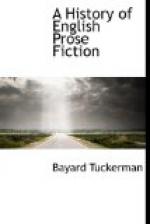The literary form of the “Morte d’Arthur” admits of description rather than of criticism. A noble and forcible simplicity of expression pervades the old Norman French in which the romances of chivalry were first written, which is well reflected in the English of Sir Thomas Malory. Of plot there is none. The same vagueness pervades the course of the narrative, which is characteristic of the historical groundwork, the geography, and the time of action. Most of the incidents depend on chance. Life in the Middle Ages was a very serious affair, and in the romances there was almost no attempt at wit or humor. In the “Morte d’Arthur,” perhaps the only passage which might have raised a laugh among the early readers of the romance, is that in which King Arthur’s fool Dagonet is clad in Sir Mordred’s armor, and in that disguise is made to chase before him the coward King Mark. The authors of the romances of chivalry never attempted delineation of character. Their heroes are good knights or bad knights, and in either case possess only the particular qualities which would place them in one of these categories. The female characters are still more slightly drawn, and show no distinct attributes except beauty and a capacity to love.
In laying down the “Morte d’Arthur,” and bidding farewell to the Middle Ages with their heroes of chivalry, we come to the end of a most picturesque period of English history,—a period marked by lights and shadows, rather than by distinct forms. There was ferocity, and there was courtesy; there was brilliant show and rude coarseness; there were scenes of blood and scenes of noble chivalry. In the next chapter we shall notice the tendencies which were at work to replace this state of society by a better. But to the Middle Ages will always be traced much that is distinctive of English character, and in the history of fiction we may fairly allow to the knights of romance the legendary charm and fascination which hang about their bright helmets in the long vista of departed years.
[Footnote 13: Hair.]
[Footnote 14: “Morte d’Arthur.” Southey’s reprint from Caxton’s ed., 1485, chaps. xix and xx. book 4.]




